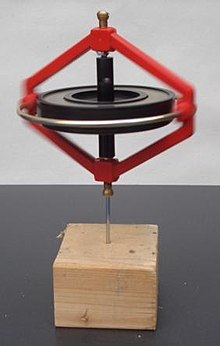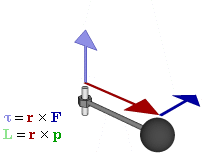https://en.wikipedia.org/wiki/Angular_momentum
In physics, angular momentum (rarely, moment of momentum or rotational momentum) is the rotational analog of linear momentum.
It is an important quantity in physics because it is a conserved quantity – the angular momentum of a system remains constant unless acted on by an external torque.
The definition of angular momentum for a point particle is a pseudovector r×p, the cross product of the particle's position vector r (relative to some origin) and its momentum vector p = mv.
This definition can be applied to each point in continua like solids or fluids, or physical fields. Unlike momentum, angular momentum does depend on where the origin is chosen, since the particle's position is measured from it.
The angular momentum of an object can also be connected to the angular velocity ω of the object (how fast it rotates about an axis) via the moment of inertia I (which depends on the shape and distribution of mass about the axis of rotation).
However, while ω always points in the direction of the rotation axis, the angular momentum L may point in a different direction depending on how the mass is distributed.
Angular momentum is additive; the total angular momentum of a system is the (pseudo)vector sum of the angular momenta.
For continua or fields one uses integration.
The total angular momentum of anything can always be split into the sum of two main components: "orbital" angular momentum about an axis outside the object, plus "spin" angular momentum through the centre of mass of the object.
Torque can be defined as the rate of change of angular momentum, analogous to force.
The conservation of angular momentum helps explain many observed phenomena, for example the increase in rotational speed of a spinning figure skater as the skater's arms are contracted, the high rotational rates of neutron stars, the falling cat problem, and precession of tops and gyros.
Applications include the gyrocompass, control moment gyroscope, inertial guidance systems, reaction wheels, flying discs or Frisbees and Earth's rotation to name a few.
In general, conservation does limit the possible motion of a system, but does not uniquely determine what the exact motion is.
In quantum mechanics, angular momentum is an operator with quantized eigenvalues. Angular momentum is subject to the Heisenberg uncertainty principle, meaning only one component can be measured with definite precision, the other two cannot.
Also, the "spin" of elementary particles does not correspond to literal spinning motion.

This gyroscope remains upright while spinning due to the conservation of its angular momentum.
In physics, angular momentum (rarely, moment of momentum or rotational momentum) is the rotational analog of linear momentum.
It is an important quantity in physics because it is a conserved quantity – the angular momentum of a system remains constant unless acted on by an external torque.
The definition of angular momentum for a point particle is a pseudovector r×p, the cross product of the particle's position vector r (relative to some origin) and its momentum vector p = mv.
This definition can be applied to each point in continua like solids or fluids, or physical fields. Unlike momentum, angular momentum does depend on where the origin is chosen, since the particle's position is measured from it.
The angular momentum of an object can also be connected to the angular velocity ω of the object (how fast it rotates about an axis) via the moment of inertia I (which depends on the shape and distribution of mass about the axis of rotation).
However, while ω always points in the direction of the rotation axis, the angular momentum L may point in a different direction depending on how the mass is distributed.
Angular momentum is additive; the total angular momentum of a system is the (pseudo)vector sum of the angular momenta.
For continua or fields one uses integration.
The total angular momentum of anything can always be split into the sum of two main components: "orbital" angular momentum about an axis outside the object, plus "spin" angular momentum through the centre of mass of the object.
Torque can be defined as the rate of change of angular momentum, analogous to force.
The conservation of angular momentum helps explain many observed phenomena, for example the increase in rotational speed of a spinning figure skater as the skater's arms are contracted, the high rotational rates of neutron stars, the falling cat problem, and precession of tops and gyros.
Applications include the gyrocompass, control moment gyroscope, inertial guidance systems, reaction wheels, flying discs or Frisbees and Earth's rotation to name a few.
In general, conservation does limit the possible motion of a system, but does not uniquely determine what the exact motion is.
In quantum mechanics, angular momentum is an operator with quantized eigenvalues. Angular momentum is subject to the Heisenberg uncertainty principle, meaning only one component can be measured with definite precision, the other two cannot.
Also, the "spin" of elementary particles does not correspond to literal spinning motion.

Contents
- 1 Angular momentum in classical mechanics
- 2 Angular momentum (modern definition)
- 3 Angular momentum in quantum mechanics
- 4 Angular momentum in electrodynamics
- 5 Angular momentum in optics
- 6 History
- 7 See also
- 8 Footnotes
- 9 References
- 10 External links

Relationship between force (F), torque (τ), momentum (p), and angular momentum (L) vectors in a rotating system. (r) is the radius.

A figure skater conserves angular momentum – her rotational speed increases as her moment of inertia decreases by drawing in her arms and legs.
Spin, orbital, and total angular momentum
Main article: Spin (physics)The classical definition of angular momentum asAngular momenta of a classical object.
Left: "spin" angular momentum S is really orbital angular momentum of the object at every point,
right: extrinsic orbital angular momentum L about an axis,
top: the moment of inertia tensor I and angular velocity ω (L is not always parallel to ω),[28]
bottom: momentum p and its radial position r from the axis.The total angular momentum (spin plus orbital) is J. For a quantum particle the interpretations are different; particle spin does not have the above interpretation.can be carried over to quantum mechanics, by reinterpreting r as the quantum position operator and p as the quantum momentum operator. L is then an operator, specifically called the orbital angular momentum operator.
However, in quantum physics, there is another type of angular momentum, called spin angular momentum, represented by the spin operator S. Almost all elementary particles have spin. Spin is often depicted as a particle literally spinning around an axis, but this is a misleading and inaccurate picture: spin is an intrinsic property of a particle, unrelated to any sort of motion in space and fundamentally different from orbital angular momentum. All elementary particles have a characteristic spin, for example electrons have "spin 1/2" (this actually means "spin ħ/2") while photons have "spin 1" (this actually means "spin ħ").
Finally, there is total angular momentum J, which combines both the spin and orbital angular momentum of all particles and fields. (For one particle, J = L + S.) Conservation of angular momentum applies to J, but not to L or S; for example, the spin–orbit interaction allows angular momentum to transfer back and forth between L and S, with the total remaining constant. Electrons and photons need not have integer-based values for total angular momentum, but can also have fractional values.[29]
Spin, orbital, and total angular momentum
Main article: Spin (physics)
Angular momenta of a classical object.
Left: "spin" angular momentum S is really orbital angular momentum of the object at every point,
right: extrinsic orbital angular momentum L about an axis,
top: the moment of inertia tensor I and angular velocity ω (L is not always parallel to ω),[28]
bottom: momentum p and its radial position r from the axis.The total angular momentum (spin plus orbital) is J. For a quantum particle the interpretations are different; particle spin does not have the above interpretation.
The classical definition of angular momentum as L = r × p {\displaystyle \mathbf {L} =\mathbf {r} \times \mathbf {p} } \mathbf {L} =\mathbf {r} \times \mathbf {p} can be carried over to quantum mechanics, by reinterpreting r as the quantum position operator and p as the quantum momentum operator. L is then an operator, specifically called the orbital angular momentum operator.
However, in quantum physics, there is another type of angular momentum, called spin angular momentum, represented by the spin operator S. Almost all elementary particles have spin. Spin is often depicted as a particle literally spinning around an axis, but this is a misleading and inaccurate picture: spin is an intrinsic property of a particle, unrelated to any sort of motion in space and fundamentally different from orbital angular momentum. All elementary particles have a characteristic spin, for example electrons have "spin 1/2" (this actually means "spin ħ/2") while photons have "spin 1" (this actually means "spin ħ").
Finally, there is total angular momentum J, which combines both the spin and orbital angular momentum of all particles and fields. (For one particle, J = L + S.) Conservation of angular momentum applies to J, but not to L or S; for example, the spin–orbit interaction allows angular momentum to transfer back and forth between L and S, with the total remaining constant. Electrons and photons need not have integer-based values for total angular momentum, but can also have fractional values.[29]
https://en.wikipedia.org/.../File:Classical_angular...
Hla Myint Angular momenta of a classical object. Left: "spin" angular momentum S is really orbital angular momentum of the object at every point, right: extrinsic orbital angular momentum L about an axis, top: the moment of inertia tensor I and angular velocity ω (L is not always parallel to ω),[28] bottom: momentum p and its radial position r from the axis.The total angular momentum (spin plus orbital) is J. For a quantum particle the interpretations are different; particle spin does not have the above interpretation.



No comments:
Post a Comment